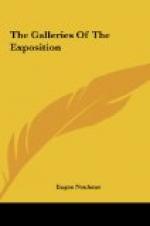Gallery 67.
This large room continues to hold the attention of the visitor by more excellent specimens of present-day art. Dougherty’s marines as well as Waugh’s very precise, somewhat metallic seascapes have been referred to before. Dougherty’s group of four pictures is augmented by two Spanish canvases by Lewis Cohen, of which the one to the right is far more convincing than the other. They are somewhat artificial in colour. Emil Carlsen’s only contribution, a fine open sea, has a quality all its own. The feeling of pattern in sky and water surface, combined with great delicacy and suggestion of absolute truthfulness, gives it a quality quite apart from the energetic art of Waugh, Ritschel, and Dougherty. John F. Carlson always has style to his work, a certain unaffected, noble simplicity, well brought out in three sympathetic pictures grouped near the Emil Carlsen marine. Adding to the conspicuousness of that wall, Charles H. Davis and Leonard Ochtman hold their own in their important setting. The only two figure pictures in this neighborhood are particularly lovely in colour and design, and R. P. R. Neilson deserves much praise for having struck a unique note conspicuous among the many commonplace portraits of the present day. Wendt’s “Land of Heart’s Desire” is unusually happy, and it supports its title admirably. Very decorative in feeling, it is compelling in its appeal to the public. Maynard Dixon, another Californian, shows an original small canvas, “The Oregon Trail,” endowed with big feeling.
Two cases in this gallery encourage investigation of American accomplishments in the field of animal sculpture, and on closer examination of offerings in this most interesting field, we find an unusually creditable lot of work by Frederick Roth, Albert Laessle, Arthur Putnam, and Charles Cary Rumsey. They should be considered in a group if their relative merit is to be fully appreciated. Kemeys and Proctor somewhat antedate them all in their work (in galleries 69 and 72). Roth is next door to Kemeys in 45, among a variety of things done mostly in glazed clay. A very fine sense of humor comes to the surface most conspicuously in “The Butcher”, “The Baker”, and “The Candlestick Maker”. Putnam and Laessle are in this gallery side by side. In sharp contrast with the former’s muscular and broad type of modeling, the latter has a very precise and Japanesque quality of detail modeling which is sometimes a little photographic. Charles Cary Rumsey is only a few steps away, in gallery 48. In his original subject of a horse and man drinking he strikes a particularly unique note.
Gallery 80.




